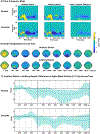Dynamics of alpha suppression index both modality specific and general attention processes
- PMID: 36863549
- PMCID: PMC10037550
- DOI: 10.1016/j.neuroimage.2023.119956
Dynamics of alpha suppression index both modality specific and general attention processes
Abstract
EEG alpha power varies under many circumstances requiring visual attention. However, mounting evidence indicates that alpha may not only serve visual processing, but also the processing of stimuli presented in other sensory modalities, including hearing. We previously showed that alpha dynamics during an auditory task vary as a function of competition from the visual modality (Clements et al., 2022) suggesting that alpha may be engaged in multimodal processing. Here we assessed the impact of allocating attention to the visual or auditory modality on alpha dynamics at parietal and occipital electrodes, during the preparatory period of a cued-conflict task. In this task, bimodal precues indicated the modality (vision, hearing) relevant to a subsequent reaction stimulus, allowing us to assess alpha during modality-specific preparation and while switching between modalities. Alpha suppression following the precue occurred in all conditions, indicating that it may reflect general preparatory mechanisms. However, we observed a switch effect when preparing to attend to the auditory modality, in which greater alpha suppression was elicited when switching to the auditory modality compared to repeating. No switch effect was evident when preparing to attend to visual information (although robust suppression did occur in both conditions). In addition, waning alpha suppression preceded error trials, irrespective of sensory modality. These findings indicate that alpha can be used to monitor the level of preparatory attention to process both visual and auditory information, and support the emerging view that alpha band activity may index a general attention control mechanism used across modalities.
Keywords: Alpha suppression; Attention control; Auditory selective attention; EEG alpha power; Preparatory control; Visual selective attention.
Copyright © 2023 The Author(s). Published by Elsevier Inc. All rights reserved.
Conflict of interest statement
Declaration of Competing Interest The authors declare that they have no known competing financial interests or personal relationships that could have appeared to influence the work reported in this paper.
Figures







References
-
- Banerjee S, Snyder AC, Molholm S, Foxe JJ, 2011. Oscillatory alpha-band mechanisms and the deployment of spatial attention to anticipated auditory and visual target locations: supramodal or sensory-specific control mechanisms? J. Neurosci 31 (27), 9923–9932. doi: 10.1523/JNEUROSCI.4660-10.2011. - DOI - PMC - PubMed
-
- Cohen MX, 2014. Analyzing Neural Time Series Data. Massachusetts Institute of Technology, Cambridge, MA.
Publication types
MeSH terms
Grants and funding
LinkOut - more resources
Full Text Sources

